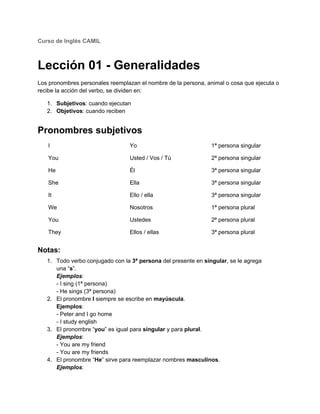
Lesson 01 generalities
- 1. Curso de Inglés CAMIL Lección 01 - Generalidades Los pronombres personales reemplazan el nombre de la persona, animal o cosa que ejecuta o recibe la acción del verbo, se dividen en: 1. Subjetivos: cuando ejecutan 2. Objetivos: cuando reciben Pronombres subjetivos I Yo 1ª persona singular You Usted / Vos / Tú 2ª persona singular He Él 3ª persona singular She Ella 3ª persona singular It Ello / ella 3ª persona singular We Nosotros 1ª persona plural You Ustedes 2ª persona plural They Ellos / ellas 3ª persona plural Notas: 1. Todo verbo conjugado con la 3ª persona del presente en singular, se le agrega una “s”. Ejemplos: - I sing (1ª persona) - He sings (3ª persona) 2. El pronombre I siempre se escribe en mayúscula. Ejemplos: - Peter and I go home - I study english 3. El pronombre “you” es igual para singular y para plural. Ejemplos: - You are my friend - You are my friends 4. El pronombre “He” sirve para reemplazar nombres masculinos. Ejemplos:
- 2. - Charles is young / He is young - John is old / He is old 5. El pronombre “she” se utiliza para reemplazar nombres femeninos. Ejemplos: - Lucy is pretty / She is pretty - Alexa is ugly / She is ugly 6. El pronombre “it” se usa para reemplazar nombres animales y cosas en singular y también como sujeto de frases impersonales como el tiempo, la medida, el clima, etc. Ejemplos: - It is my dog - It is hot - It is 10 inches long - It is 10 O’Clock there - Where is the book? 7. Cuando un animal es muy doméstico y se le trata como persona, su nombre se puede reemplazar por “he” o “she”. 8. Tradicionalmente los nombres de países, océanos y barcos se han reemplazado por el pronombre “she”, aunque esta tendencia viene cambiando poco a poco con el inglés moderno. Ejemplos: - Canada is a very cold country - She is a very cold country 9. El pronombre “they” reemplaza nombres de personas, animales o cosas en plural, sin distinción de género. Ejemplos: - Peter and Marie dance well / They dance well - Birds sing and fly / They sing and fly - My flowers are nice / They are nice 10. El pronombre “we”. Ejemplos: - We are learning English - We are secretaries 11. Todo verbo conjugado en presente simple y con un sustantivo singular en 3ª persona debe llevar una “s”. Ejemplos: - He works every day - She learns very much - It costs two dollars 12. En inglés toda frase debe llevar siempre sujeto expreso y no tácito como suele suceder en el español. Ejemplos: - Estudio inglés de lunes de lunes a jueves / I study englis from monday to thursday - Estamos hablando mucho / we are talking a lot - Estuvieron bailando anoche / They are dancing last night
- 3. 13. El adjetivo siempre va antes del sustantivo o después del verbo ser o estar. Ejemplos: - The big house is dirty - The small apartment is clean - The house is beautiful 14. En inglés el adjetivo es invariable, es decir, siempre está en singular. Ejemplos: - The yellow pencil is on the table - The yellows pencils are on the table
